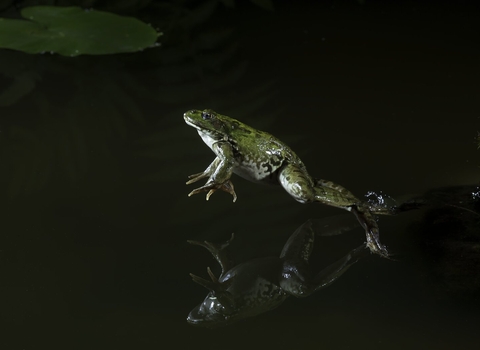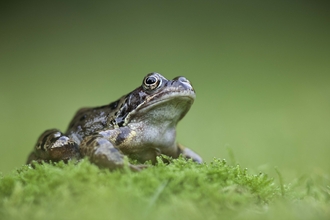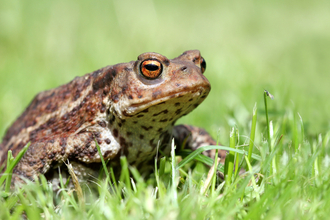
Marsh frog © Jim Higham

Marsh frog © Dale Sutton/2020vision
Marsh frog
Europe's largest frog is not naturally found in the UK, but was introduced to Kent and has spread throughout the southeast.
Scientific name
Pelophylax ridibundus (formerly Rana ridibunda)When to see
April to OctoberSpecies information
Category
Statistics
Length: up to 15cmConservation status
Not native to the UK. Classified as Least Concern by the IUCN
Habitats
About
The marsh frog is Europe's largest frog, naturally found in a wide range across Europe and east into Asia. They are not native to the UK, but a small number were released at a site in Kent in the 1930s and were able to survive in the wild. Over the next few decades they spread into the surrounding wetlands and can now be found throughout the southeast of England. Their spread was aided by more people releasing marsh frogs into the wild, and some scattered populations exist in other parts of the UK. Releasing marsh frogs into the wild is now classed as a criminal offence under the Wildlife and Countryside Act 1981.Marsh frogs are much more closely tied to water than common frogs, and are almost always found either in the water or next to it, poised to leap in at the first sign of an approaching predator - they're a popular snack for herons, egrets and grass snakes. They prefer open wetlands, with plenty of sunlight to warm them and lots of aquatic plants to lay eggs on, but are highly adaptable and can be found in anything from marshes to ditches, ponds, streams, and large lakes. They can even put up with brackish water, where the salt content is higher than freshwater but not quite as salty as seawater.
During the breeding season in spring and summer, the male frogs advertise with loud bursts of quacking croaks, almost as if they are laughing. They produce such an impressive sound by inflating two vocal sacs, which push out from each side of their head like giant bubbles. These air-filled sacks amplify their calls, so they can be heard clearly from some distance away. Once one male starts to call, his neighbours soon join in, until the whole wetland is filled with a chorus of cackling.
Unlike common frogs, female marsh frogs don't lay eggs in large clumps on the surface. They deposit their eggs in smaller batches underwater, attached to plants. Another difference between them is that common frogs usually leave ponds soon after spawning, whereas marsh frogs stay close to the water all year. Marsh frogs aren't too picky about what they eat, so their diet depends on whatever prey is available. They mostly feed on invertebrates, but will also eat small fish, reptiles and amphibians - including other marsh frogs.
How to identify
Marsh frogs are large (around 50% bigger than a common frog), with a rounded snout and warty skin that varies from olive to bright green, with irregular dark blotches. There is sometimes a bright green or yellow line running down the centre of the back. Their underside is creamy white. They also have a ridge running along each side of the body, starting just behind the eye. Marsh frogs don't have the dark 'mask' behind the eye, which is seen on common frogs.The marsh frog is part of a group of similar species sometimes known as 'green frogs' or 'water frogs', which can be tricky to separate. Other green frogs found in the UK are the edible frog, which is another introduced non-native species with a few scattered populations, and the pool frog - a native species which was driven to extinction in the UK, but has been successfully reintroduced to East Anglia. The marsh frog is generally larger than the other two species.


